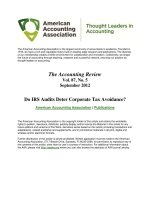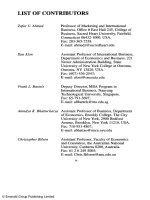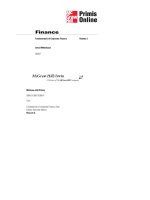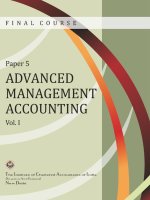YTC Price Action Trader vol 1
Bạn đang xem bản rút gọn của tài liệu. Xem và tải ngay bản đầy đủ của tài liệu tại đây (278.74 KB, 23 trang )
Volume One - Introduction
YTC Price Action Trader
by Lance Beggs
Published by:
LB68 Publishing
PO Box 4097
Kirwan QLD 4817
Copyright © 2010. Lance Beggs. All rights reserved.
No part of this publication may be reproduced or transmitted in any form or by any means,
electronic or mechanical, without written permission from the publisher, except as permitted by
Australian Copyright Laws.
First Edition, 2010.
Published in Australia.
© Copyright 2010. Lance Beggs, www.YourTradingCoach.com. All Rights Reserved
2
No Reprint Rights
While other YTC eBooks ( /ebooks.html) specifically authorise Free Reprint Rights, this does
NOT apply to the YTC Price Action Trader series.
The YTC Price Action Trader series is subject to standard copyright laws.
You are not authorised to share this eBook via electronic means, including forwarding a copy to
your friends, sharing it with your newsletter subscribers, hosting it on your website, or including
it as a free bonus with any other trading product.
Affiliate Sales
If you find this six-volume series of ebooks to be of great value and wish to offer it for sale to
your own customers or website/blog readers, I encourage you to sign up as an affiliate.
More information, including details on affiliate commissions, is listed at the following webpage:
www.YourTradingCoach.com/Affiliate.html
© Copyright 2010. Lance Beggs, www.YourTradingCoach.com. All Rights Reserved
3
Disclaimer
The information provided within the YTC Price Action Trader ebook series and any supporting documents, websites
and emails is GENERAL COMMENT ONLY, for the purposes of information and education. We don't know you
so any information we provide does not take into account your individual circumstances, and should NOT be
considered advice. Before investing or trading on the basis of this material, both the author and publisher encourage
you to first SEEK PROFESSIONAL ADVICE with regard to whether or not it is appropriate to your own
particular financial circumstances, needs and objectives.
The author and publisher believe the information provided is correct. However we are not liable for any loss, claims,
or damage incurred by any person, due to any errors or omissions, or as a consequence of the use or reliance on any
information contained within the YTC Price Action Trader ebook series and any supporting documents, websites
and emails.
Reference to any market, trading timeframe, analysis style or trading technique is for the purpose of information and
education only. They are not to be considered a recommendation as being appropriate to your circumstances or
needs.
All charting platforms and chart layouts (including timeframes, indicators and parameters) used within this ebook
series are being used to demonstrate and explain a trading concept, for the purposes of information and education
only. These charting platforms and chart layouts are in no way recommended as being suitable for your trading
purposes.
Charts, setups and trade examples shown throughout this product have been chosen in order to provide the best
possible demonstration of concept, for information and education purposes. They were not necessarily traded live by
the author.
U.S. Government Required Disclaimer:
Commodity Futures Trading and Options trading has large potential rewards, but also large potential risk. You must
be aware of the risks and be willing to accept them in order to invest in the futures and options markets. Don't trade
with money you can't afford to lose. This is neither a solicitation nor an offer to Buy/Sell futures or options. No
representation is being made that any account will or is likely to achieve profits or losses similar to those discussed
on this web site. The past performance of any trading system or methodology is not necessarily indicative of future
results.
CFTC RULE 4.41 - HYPOTHETICAL OR SIMULATED PERFORMANCE RESULTS HAVE CERTAIN
LIMITATIONS. UNLIKE AN ACTUAL PERFORMANCE RECORD, SIMULATED RESULTS DO NOT
REPRESENT ACTUAL TRADING. ALSO, SINCE THE TRADES HAVE NOT BEEN EXECUTED, THE
RESULTS MAY HAVE UNDER-OR-OVER COMPENSATED FOR THE IMPACT, IF ANY, OF CERTAIN
MARKET FACTORS, SUCH AS LACK OF LIQUIDITY. SIMULATED TRADING PROGRAMS IN GENERAL
ARE ALSO SUBJECT TO THE FACT THAT THEY ARE DESIGNED WITH THE BENEFIT OF HINDSIGHT.
NO REPRESENTATION IS BEING MADE THAT ANY ACCOUNT WILL OR IS LIKELY TO ACHIEVE
PROFIT OR LOSSES SIMILAR TO THOSE SHOWN
© Copyright 2010. Lance Beggs, www.YourTradingCoach.com. All Rights Reserved
4
About the Author
Lance Beggs is a full time day-trader with a current preference for forex, FX futures and eminifutures markets. His style of trading is discretionary, operating in the direction of short-term
sentiment within a framework of support and resistance.
As an ex-military helicopter pilot and aviation safety specialist, Lance has an interest in applying
the lessons and philosophy of aviation safety to the trading environment, through study in human
factors, risk management and crew resource management.
He is the founder and chief contributor to , which aims to provide quality trading education
important aspects of trading –
and resources with an emphasis on the ‘less sexy’ but more
business management, risk management, money management and trading psychology.
Lance can be contacted via
© Copyright 2010. Lance Beggs, www.YourTradingCoach.com. All Rights Reserved
5
“Develop a passion for learning.
If you do, you will never cease to grow.”
…Anthony J. D’Angelo
© Copyright 2010. Lance Beggs, www.YourTradingCoach.com. All Rights Reserved
6
Table of Contents
Volume One – Introduction
Chapter One – Introduction
15 1.1 – Introduction………………………………………………………………...
17 1.2 – Scope – Strategy, Markets & Timeframes………………………………….
19 1.3 – Acknowledgments………………………………………………………….
19 1.4 – Prerequisites………………………………………………………………...
20 1.5 – Feedback……………………………………………………………………
20 1.6 – Contents Overview…………………………………………………………
Volume Two – Markets and Market Analysis
Chapter Two – Principles of Markets
15 2.1 – Principles of Markets……………………………………………………….
16 2.2 – The Reality of the Markets…………………………………………………
16
2.2.1 – Trading the Shadows……………………………………………..
19
2.2.2 – Cause and Effect………………………………………………….
22
2.2.3 – What is Price?…………………………………………………….
23
2.2.4 – How Does Price Move? ………………………………………….
2.2.5 – What are Markets…………………………………………………
32
37
2.2.6 – Summary – The Reality of the Markets…………………………...
38 2.3 – The Reality of the Trading Game…………………………………………..
38
2.3.1 – How Do We Profit? ………………………………………………
39
2.3.2 – Analysis for Profit…………………………………………………
43 2.4 – Effective vs Ineffective Trading Strategies and Systems…………………..
50
2.4.1 – Principles of my Effective Strategy……………………………….
52 2.5 – Conclusion.…………………………………………………………………
Chapter Three – Market Analysis
54 3.1 – Introduction to Market Analysis…………………………………………...
54
3.1.1 – The Aim of our Market Analysis………………………………….
55
3.1.2 – Subjectivity vs Objectivity in Market Analysis……………………
57 3.2 – Past Market Analysis……………………………………………………….
57
3.2.1 – Support and
Resistance……………………………………………
Www.ForexWinners.Net
© Copyright 2010. Lance Beggs, www.YourTradingCoach.com. All Rights Reserved
7
72
79
90
113
113
116
145
153
156
160
160
161
165
172
173
180
184
186
186
186
189
3.2.2 – Multiple Timeframe Analysis……………………………………...
3.2.3 – Market Structure…………………………………………………..
3.2.4 – Trends……………………………………………………………..
3.3 – Future Trend………………………………………………………………...
3.3.1 – Strength and Weakness……………………………………………
3.3.2 – Identifying Strength and Weakness……………………………….
3.3.3 – Principles of Future Trend Direction…………………………….
3.3.4 – Visualising the Future…………………………………………….
3.3.5 – What Happens After S/R Holds? …………………………………
3.4 – Initial Market Analysis Process…………………………………………….
3.4.1 – Initial Market Analysis Process Summary………………..………
3.4.2 – Initial Market Analysis Checklist...……………………………….
3.4.3 – Initial Market Analysis Example………………………………….
3.5 – Ongoing Market Analysis – Theory………………………………………...
3.5.1 – Determine Candle Pattern Sentiment…………………………….
3.5.2 – Consider the Context……………………………………………...
3.5.3 – Does it Support our Premise? ……………………………………
3.6 – Ongoing Market Analysis Process………………………………………….
3.6.1 – Ongoing Market Analysis Process Summary……………………..
3.6.2 – Ongoing Market Analysis Checklist………………………………
3.6.3 – Ongoing Market Analysis Example………………………………
3.7 – Practice……………………………………………………………………..
200
3.7.1 – Market Structure Journal…………………………………………
201
202
3.8 – Conclusion………………………………………………………………….
3.9 – Addendum to Chapter 3 – Alternative Questions for the Conduct of Price
203
Action Analysis…………………………………………………………….
Volume Three – Trading Strategy
Chapter Four – Strategy – YTC Price Action Trader
15 4.1 – Strategy – YTC Price Action Trader……………………………………....
15 4.2 – Setup Concept……………………………………………………………..
15
4.2.1 – The Expectancy Formula………………………………………..
17
4.2.2 – Principles behind the YTC Price Action Trader Setup Locations.
25 4.3 – YTC Price Action Trader Setups…………………………………………..
25
4.3.1 – Setup Definition…………………………………………………..
41
4.3.2 – Setups Appropriate for each Particular Market Environment…...
54
4.3.3 – Revisiting the Initial Market Analysis Process and Checklist……
56
4.3.4 – More Action – Trading In-between Setup Areas…………………
56
4.3.5 – When Price Enters Setup Areas…………………………………..
© Copyright 2010. Lance Beggs, www.YourTradingCoach.com. All Rights Reserved
8
57
57
64
70
99
119
119
120
123
123
4.4 – Trading the Setups…………………………………………………………
4.4.1 – Stop Placement………………………………………………….
4.4.2 – Targets…………………………………………………………..
4.4.3 – Entry…………………………………………………………….
4.4.4 – Trade Management……………………………………………..
4.5 – The Trading Process………………………………………………………
4.5.1 – Trading Process Diagram………………………………………
4.5.2 – Trading Process Checklist………………………………………
4.6 – Practice……………………………………………………………………
4.7 – Conclusion………………………………………………………………...
Chapter Five – Trade Examples
126
5.1 – Trade Example 1 – BPB – T1 & T2 Achieved……………………………
138
5.2 – Trade Example 2 – PB – T1 Achieved – Part Two Worked Exit…………
5.3 – Trade Examples 3 – BOF, BPB, TST – Sideways Trend within another
152
Sideways Trend………………………………………..…….……………
167
5.4 – Trade Example 4 – CPB – T1 Achieved – T2 Trailed……….……………
177
5.5 – Trade Example 5 – TST – Part 1 Stopped Breakeven - Part 2 Trailed……
189
5.6 – Trade Example 6 – BOF – T1 & T2 Achieved……………………………
5.7 – Trade Example 7 – TST – Part 1 Scratched, Re-entered & Stopped Out –
200
Part 2 Stopped Out………………..……………………………………....
213
5.8 – Trade Example 8 – PB – Scratched – No Re-entry……………………….
225
5.9 – Trade Example 9 – CPB – T1 & T2 Achieved……………………………
5.10 – Trade Example 10 – TST – Scratched & Reversed - PB – T1 Achieved –
235
Part 2 Stopped (Trail)..……..…………………………………….………...
250
5.11 – Trade Example Summary Notes………………………………….………
Chapter Six – Other Markets, Other Timeframes
253
6.1 – Other Markets, Other Timeframes………………………………………...
255
6.2 – Examples – Forex………………………………………………………….
261
6.2.1 – Additional Forex Considerations………………………………..
264
6.3 – Examples – Emini Futures………………………………………………...
269
6.3.1 – Additional Emini Futures Considerations……………………….
271
6.4 – Examples – Stocks & ETFs……………………………………………….
275
6.4.1 – Additional Stock & ETF Considerations………………………..
276
6.5 – Conclusion………………………………………………………………...
© Copyright 2010. Lance Beggs, www.YourTradingCoach.com. All Rights Reserved
9
Volume Four – Your Trading Business
Chapter Seven – Money Management
15 7.1 – Ensuring Survival………………………………………………………….
15 7.2 – Financial Survival………………………………………………………….
15 7.3 – Money Management……………………………………………………….
Chapter Eight – Contingency Management
8.1 – Contingency Management…………………………………………………
8.1.1 – Contingency Management……………………………………….
26
26
Chapter Nine – Goals & Targets
30 9.1 – What Win% Should You Expect?................................................................
31 9.2 – Ok… If I Absolutely Must!..........................................................................
31 9.3 – Stats………………………………………………………………………..
32 9.4 – Another Option – For the Consistently Profitable………………………...
Chapter Ten – Trading Psychology – A Practical Approach
37 10.1 – Personal Survival…………………………………………………………
37 10.2 – Prerequisites for Survival………………………………………………...
42 10.3 – Mastery of Trading Psychology………………………………………….
42
10.3.1 – Focus on Process………………………………………………
45
10.3.2 – Peak Performance Mindset…………………………………….
53 10.4 – Maintenance of Peak Physical Condition………………………………..
58 10.5 – Psych Wrap-Up…………………………………………………………..
58 10.6 – Additional Study…………………………………………………………
Chapter Eleven – Trading Platform Setup
11.1 – Trading Platform Setup…………………………………………………..
60
Chapter Twelve – Trading Plan
65 12.1 – Trading Plan………………………………………………………………
67 12.2 – Trading Plan Template……………………………………………………
69 12.3 – Trading Plan – Explanatory Notes………………………………………..
69
12.3.1 – Cover Page……………………………………………………..
69
12.3.2 – Preface………………………………………………………….
70
12.3.3 – Introduction……………………………………………………..
70
12.3.4 – The Trader………………………………………………………
71
12.3.5 – The Trading Business……………………………………………
74
12.3.6 – The Trading Process…………………………………………….
© Copyright 2010. Lance Beggs, www.YourTradingCoach.com. All Rights Reserved
10
12.3.7 – Annexes…………………………………………………………
76
Chapter Thirteen – Procedures Manual
13.1 – Procedures Manual………………………………………………………..
13.2 – Sample Procedures Manual……………………………………………….
78
78
Chapter Fourteen – Additional Documentation
106 14.1 – Additional Documentation……………………………………………….
106 14.2 – Trading Journal Spreadsheet……………………………………………..
106 14.3 – Trading Log………………………………………………………………
108 14.4 – Motivation Journal………………………………………………………..
108 14.5 – Lessons Learnt Journal……………………………………………………
109 14.6 – Market Structure Journal………………………………………………….
110 14.7 – Trades Journal…………………………………………………………….
Volume Five – Trader Development
Chapter Fifteen – The Journey
15.1 – FACT: Most Readers Will Fail to Achieve Consistent Profitability…….
15.2 – The Journey………………………………………………………………
15
17
Chapter Sixteen – The Learning Process
20 16.1 – Effective Learning……………………………………………………….
20 16.2 – Deliberate Practice……………………………………………………….
21 16.3 – Trade-Record-Review-Improve………………………………………….
22 16.4 – Deliberate Practice Tools and Techniques……………………………….
22
16.4.1 – Defined Trading Procedures…………………………………...
22
16.4.2 – Trading Logs and Journals…………………………………….
22
16.4.3 – Documented Review Process…………………………………..
23
16.4.4 – Market Replay………………………………………………….
26
16.4.5 – Market Replay Alternatives…………………………………….
26
16.4.6 – Peer Review……………………………………………………
Chapter Seventeen – Taking Action
29 17.1 – Taking Action…………………………………………………………….
29 17.2 – The Development Stages…………………………………………………
30
17.2.1 – Stage 1 – Establish Your Foundation…………………………..
33
17.2.2 – Stage 2 – Simulator Environment………………………………
34
17.2.3 – Stage 3 – Live Environment – Minimum Size…………………..
© Copyright 2010. Lance Beggs, www.YourTradingCoach.com. All Rights Reserved
11
35
35
36
37
41
41
17.2.4 – Stage 4 – Live Environment – Increasing Size…………………
17.2.5 – As You Progress………………………………………………..
17.3 – Taking Action – Alternate Strategies…………………………………….
17.4 – Challenges and Difficulties………………………………………………
17.5 – The Target………………………………………………………………..
17.6 – Additional Study………………………………………………………….
Volume Six – Conclusion
Chapter Fourteen – Conclusion
15 18.1 – Summary………………………………………………………………….
15
18.1.1 – Principles of Markets –Summary……………………………….
17
18.1.2 – Market Analysis –Summary…………………………………….
20
18.1.3 – Trading Strategy –Summary……………………………………
29
18.1.4 – Setups Poster……………………………………………………
18.1.5 – The Learning Process –Summary………………………………
30
31 18.2 – For Those Concerned That It Appears Too Simple……………………….
32 18.3 – And For Those Who Perceive It As Too Complex……………………….
32 18.4 – Take Action……………………………………………………………….
33 18.5 – Wrap Up…………………………………………………………………..
33 18.6 – Supplementary Resources…………………………………………………
© Copyright 2010. Lance Beggs, www.YourTradingCoach.com. All Rights Reserved
12
VOLUME ONE
INTRODUCTION
© Copyright 2010. Lance Beggs, www.YourTradingCoach.com. All Rights Reserved
13
Chapter One - Introduction
© Copyright 2010. Lance Beggs, www.YourTradingCoach.com. All Rights Reserved
14
1.1- Introduction
Welcome to the YTC Price Action Trader.
I have two primary aims for this book.
1) To share with you the way that I view the financial markets and the way that I use
price action to identify and manage trade opportunity.
2) To share with you the development process that I believe you need to follow in order
to become a consistently profitable and professional trader, regardless of the strategy
you choose to implement.
Of these two primary aims, the second is by far the most important.
New traders mistakenly believe success is all about the right knowledge and the right strategy.
While this is important, they fail to understand that becoming a trader is really a process of
growth and development. Success is not a result of one day finding the right combination of
indicators or parameters and the right set of trading rules. Success comes through a process of
learning to trust yourself as you operate within an environment of uncertainty. Trusting your
ability to make effective decisions, to manage risk, and to identify and manage opportunity.
In drafting this book I initially placed this material at the beginning, prior to any discussion of
strategy. My fears though, were that too many would be tempted to skip over this information in
an attempt to get to what they perceived to be the higher value material – the strategy.
So, right or wrong, I’ve reworked the text to place this material at the end. And to be honest I
feel it works better this way.
The real learning begins beyond the final pages of this book as you gain exposure to the
uncertain nature of the markets. By structuring the book as I have, the routines and procedures
required to ensure an effective learning process will be freshest in your mind.
If I have done my job well, you’ll clearly understand the path that lay ahead of you and be
approaching that journey well prepared for the challenges it will provide. You’ll have a newly
discovered interest in learning theory, decision making, trading psychology, as well as risk and
money management.
But don’t worry… we will discuss markets and strategy as well.
© Copyright 2010. Lance Beggs, www.YourTradingCoach.com. All Rights Reserved
15
While not unique to me, you’ll find the way I view the markets to be different to the way the
majority approach this game. It was this change in perspective which resulted in one of the
greatest advances in my own development as a trader. I hope it has the same impact on you.
The strategy shared within this book is a discretionary method of trading. It is not a simple “buy
on trigger A and sell on trigger B” system. Such simple systems do not work, no matter how
much we wish they did. Spend a day surfing any of the numerous systems forums and you’ll see
this for yourself. Many systems are presented which appear to offer great potential, generating
excitement amongst the forum participants and a flurry of posting activity. Ultimately they fade
away to nothing as the participants discover the system fails to deliver consistent results, or they
become frustrated as it morphs into a completely different system as filter after filter is applied to
try to overcome its limitations.
As you discover the way I view the markets you’ll understand why these systems don’t work.
Typically they’re based upon a false premise; a false understanding of the market environment
and a false understanding of the reality of the trading game.
In the chapters which follow, you’ll discover the reality of the market environment and finally
understand what this game is really all about. And you’ll be free from the illusion that leads to so
many traders being stuck on the seemingly never-ending search for the Holy Grail trading
system.
Unfortunately though, discovering reality doesn’t make this an easy game. But at least you’ll
finally be on the right path.
I will be sharing the strategy that I use. However I can’t guarantee that it will suit your needs and
provide you with consistent profitability. It is a discretionary strategy. Hence the importance of
understanding the key points within the disclaimer at the start of this document; understanding
that trading does expose you to risk and that you’ll most likely lose money as you progress
through the growth and development process.
In applying the strategy, you’ll be required to use your own discretion and intuition. Results will
therefore depend on your own level of growth and development. You can’t learn to ride a bike
through reading a book; it requires experience. Trading is the same. This book will provide you
with the underlying theory of the markets and a strategy which is designed to operate within that
market reality. This is a starting point only; the real learning comes through exposure to the
market environment.
Ultimately, I don’t expect to create carbon-copies of myself. The reality is that we are all
different people operating with different perceptual and decision making abilities. Your
application of my strategy will be uniquely yours. So don’t be afraid as you progress through the
trader development phase to experiment with changes to the strategy. Take what works for you,
© Copyright 2010. Lance Beggs, www.YourTradingCoach.com. All Rights Reserved
16
and discard what doesn’t; blending my approach with your previous knowledge and experience
to create your own work of art. Provided the end result is based upon the reality of the markets,
as we’ll discuss in Volume Two, and the application of your strategy has been developed via the
trader development process we’ll discuss in Volume Five, you’ll be on the right path.
1.2– Scope – Strategy, Markets & Timeframes
The strategy presented in Volume Three of this book is simply called the YTC Price Action
Trader.
It is a discretionary based, swing trading strategy, which involves analysis across three
timeframes, in order identify and trade the swings on the intermediate timeframe.
Although the strategy is adaptable to any market and timeframe (provided sufficient liquidity),
the examples and discussion will primarily focus upon one market and one set of timeframes.
This will ensure simplicity as you will always know whether a particular chart relates to the
higher, intermediate or lower timeframe.
The chosen market and timeframes for demonstration of the strategy are:
6B (British Pound FX Futures, equivalent to the GBP/USD)
30 min, 3 min and 1 min charts
Why this combination? Simply because it’s one of my favorites!
Is it the only market and timeframe which works? Absolutely not!
Do not be too concerned if you wish to trade other markets and other timeframes.
Chapter Six will discuss the factors which need to be considered in adapting this strategy to
alternate markets and timeframes, as well as offer chart and setup examples. In particular we’ll
look at the forex market, the emini futures markets, and stocks, as it’s a simple process to adjust
and adapt to these markets. And we’ll look at higher timeframe considerations.
Where there are other considerations that go beyond the scope of this book, and I’m able to
provide expanded and detailed information related to these markets or timeframes (essentially
making the adaptation for you), I’ll do so via a small supplementary ebook such as the currently
planned:
© Copyright 2010. Lance Beggs, www.YourTradingCoach.com. All Rights Reserved
17
YTC Scalper
The strategy is the same; it’s just the application in these environments which has a few unique
characteristics. I’ve kept them separate from the main book as they’re not going to be of interest
to the majority of readers, who will simply trade the standard YTC Price Action Trader.
For those of you not too familiar with my website, and wondering what markets and
timeframes I currently trade…
The majority of my trading over recent years has been in applying the YTC Price Action
Trader strategy as follows:
GBP/USD (spot forex) using 60 min, 5 min and 1 min charts
Then upon discovering the cost and execution advantages of FX futures over spot forex,
this changed to:
6B (British Pound FX currency futures, equivalent to the GBP/USD) and the
YM (emini Dow futures) using 30, 3 and 1 min charts
More recently though, my trading has undergone a further evolution, as I move away
from my standard timeframes towards shorter scalping timeframes (5 min, 1 min and 20
tick charts) on the YM and TF. This has become known as the YTC Scalper variation.
Although scalping is where my current trading lies, and where I will likely have my
focus for the immediate future, I have chosen to present the original YTC Price Action
Trader markets and timeframes as the primary method discussed within this book.
The reasoning is simple - I recognize that the majority of readers will not be interested in
scalping the markets. And those that are will still get value in learning the standard
approach, prior to studying the scalping variation.
© Copyright 2010. Lance Beggs, www.YourTradingCoach.com. All Rights Reserved
18
1.3 - Acknowledgments
Unfortunately I never found one person to act as a mentor. I consider myself to be self-taught,
having developed my trading approach through trial and error.
That being said, I expect there is nothing new in my approach to trading that hasn’t been
discovered before by others. This is just my unique interpretation of a blend of information,
which has been gained from exposure to many others throughout my trading journey.
Numerous traders and educators have had significant influence in my own trader development.
There are too many to mention in full, however I would like to offer a special thanks to the
following people:
From my earlier days; Dr Alexander Elder, Dr Van Tharp, Mark Douglas, Linda Raschke.
And those who currently provide inspiration and new insight: Mike Reed, Denise Shull, Davin
Clarke, Don Miller, Sam Seiden, Toni Hansen and Dr Brett Steenbarger.
Study everything you can find that was written by these people.
Charting
Charts throughout the book have been produced using Ninja Trader (www.ninjatrader.com) and
Think or Swim (www.thinkorswim.com).
1.4 - Prerequisites
This book is not written for a complete novice. It will not explain the basics of charting and
technical analysis, which should be considered prerequisite knowledge.
If you are new to this game and are not familiar with charts, the creation of price bars or candles,
or the use of common charting patterns and technical analysis indicators, then you need to delay
reading this book until you’ve established this base-level of knowledge.
The following webpage will provide you with some recommended sources of this prerequisite
knowledge, some low-cost and some free:
/Trading-Resources.html.
© Copyright 2010. Lance Beggs, www.YourTradingCoach.com. All Rights Reserved
19
1.5- Feeback
Feedback is greatly appreciated, whether positive or negative. In fact, I absolutely encourage
feedback if you disagree with anything presented in this document. I make no claims of being a
Guru Trader who knows it all. I see myself as someone who’s perhaps been where you are right
now and who may be able to help you take the next step. I believe that no-one will ever master
this game; rather it provides us with a never-ending process of learning. While I look back at my
view of the markets even just five years ago, with a laugh at how naive I was, I would similarly
be delighted to look back at this work in another five years and see further progress and growth.
We can learn from each other.
Please send all feedback to:
I’d love to hear your thoughts.
1.6 - Contents Overview
The following provides a quick summary of the material to come…
Volume Two – Markets and Market Analysis
Chapter 2 of the series is where we discover the reality of markets and the trading game. We’ll
see the true nature of price movement and the way that I view markets that allows me to identify
areas of trade opportunity. You’ll come away with not only a new understanding of the markets,
but also an understanding of why most traders lose and why most other systems are ineffective.
Chapter 3 of the series covers market analysis. You’ll learn how I analyze price action within a
framework of support and resistance. You’ll learn to develop a bias for future price action, and
update that bias as the market data unfolds bar by bar.
Volume Three – Trading Strategy
In chapter 4, we’ll discover the YTC Price Action Trader. We’ll find out where the opportunity
for profit exists within the market structure we have created and analyzed in chapter 3. And we’ll
work through examples showing how to identify, execute and manage these trade opportunities.
© Copyright 2010. Lance Beggs, www.YourTradingCoach.com. All Rights Reserved
20
In chapter 5, we’ll review a number of trade examples, from start to finish. A common complaint
with trading books is that authors always seem to show the best trade examples; those that move
immediately from the entry trigger to great profits. Interestingly, I have also felt this temptation –
ego is an amazingly powerful force. However I’ve seen enough trading books to know that this
does not serve you well. Reality is never as neat as the textbook examples. I have therefore
attempted to show you trades based on the reality of the markets – a mixture of different setups –
some which do move to profits – but others which will stop me out, or even cause me to scratch
the trade at or around breakeven due to doubt about future profitability. Hopefully this will
provide greater benefit.
Chapter 6 will discuss implementation of the strategy in other timeframes; as well as other
markets such as forex, emini futures and stocks.
Volume 4 – Your Trading Business
Volume 4 is where we approach our trading in a business-like manner. Chapter 7 and 8 ensure
our financial survival, through establishment of our money management and contingency
management plans. Chapter 9 discusses our goals and targets.
Chapter 10 aims to ensure our personal survival, through a practical application of trading
psychology tools and techniques.
Chapter 11 sets up our trading platform.
Chapters 12 and 13 discuss the two primary documents used in our trading business – the
Trading Plan which outlines our strategy for profiting from the markets; and the Procedures
Manual, which establishes our daily pre-session, during-session and post-session routines,
contingency management and review processes.
Chapter 14 will complete our discussion of documentation, outlining the numerous journals and
spreadsheets that will be required, should you approach this challenge in a professional and
business-like manner.
© Copyright 2010. Lance Beggs, www.YourTradingCoach.com. All Rights Reserved
21
Volume Five – Trader Development
This is where we discuss the process of becoming a trader.
In Chapter 15 of the series we will reinforce the point that becoming a professional (and
consistently profitable) trader is not an end-state, but a journey of growth and self-development.
Chapter 16 will talk about the learning process – the principles, tools and techniques needed to
ensure efficient progress through your trader development journey. This is something you won’t
find in most trading books, but which I believe is of great importance.
Chapter 17, Taking Action, will provide you with some direction for the way forward, and will
establish a plan for your progression through the four stages of trader development.
Volume 6 – Conclusion
Chapter 18 wraps up the series with a summary of the main concepts.
Before you begin, I recommend spending some time skimming through the six volumes in order
to provide yourself with a bigger-picture overview and familiarize yourself with the structure of
the contents.
Enjoy!
© Copyright 2010. Lance Beggs, www.YourTradingCoach.com. All Rights Reserved
22
Resources
Trading Website:
YouTube Videos:
www.YourTradingCoach.com
/>
'Because You'd Rather Be Trading For A Living...'
© Copyright 2010. Lance Beggs, www.YourTradingCoach.com. All Rights Reserved
23









